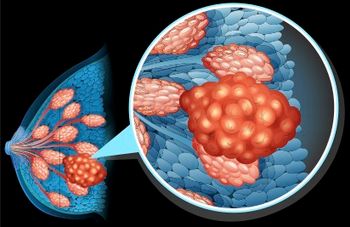
Oncology NEWS International
- Oncology NEWS International Vol 16 No 2
- Volume 16
- Issue 2
Exemestane After 5 Years of Tamoxifen Prevents Relapses
Postmenopausal breast cancer patients who received exemestane (Aromasin) after 5 years of tamoxifen cut their risk of relapse by half
• SAN ANTONIOPostmenopausal breast cancer patients who received exemestane (Aromasin) after 5 years of tamoxifen cut their risk of relapse by half, according to new data from the National Surgical Adjuvant Breast and Bowel Project (NSABP) B-33 study. Terry Mamounas, MD, NSABP Breast Committee Chairman and a surgical oncologist at the Aultman Health Foundation, Canton, Ohio, presented the results at the 29th Annual San Antonio Breast Cancer Symposium (abstract 49). "Exemestane was related to improved relapse-free survival despite early closure of the study, unblinding, and crossover of placebo patients to the treatment arm," he said.
NSABP B-33 opened in May 2001, and by October 2003 had accrued 1,598 postmenopausal breast cancer patients (stage I-II, hormone-receptor positive) who had received 5 years of tamoxifen after breast cancer surgery. Accrual was stopped at that time after the results of the National Cancer Institute of Canada's MA.17 trial showing that use of the aromatase inhibitor letrozole (Femara) reduced the risk of tumor relapse by 43% in women who had received 5 years of tamoxifen after surgery.
At the time of this announcement, NSABP B-33 placebo patients were offered exemestane, resulting in a crossover rate of 44%; in the exemestane arm, 72% of patients continued the aromatase inhibitor for 5 years total. Dr. Mamounas acknowledged the somewhat surprising proportion of active-drug recipients who discontinued exemestane, in light of the MA.17 data, and speculated that many women may have stopped exemestane in order to initiate treatment with letrozole.
Despite the heavy crossover in NSABP B-33, at a median follow-up of 30 months relapse-free survival was 96% for the exemestane arm and 94% for the placebo group (17 and 37 events, respectively), for a 56% reduction in risk
(P = .004). Disease-free survival was 91% and 89% (52 and 37 events, respectively), for a 32% reduction in risk (P = .07). There was no difference in overall survival, which was 95% with exemestane and 98% with placebo (P = .63).
While all subgroups showed benefit, significant differences favoring exemestane were observed in subgroups of patients who had tumors larger than 2 cm, who had node-positive disease, and who had received prior adjuvant chemotherapy, with risk reduced by 40% to 50% in these subsets.
"Toxicity with exemestane was acceptable for the adjuvant setting," Dr. Mamounas said. Each group reported a grade 4 toxicity rate of 1%; grade 3 toxicity was observed in 9% with exemestane vs 6% with placebo (P = .03). The most common grade 3-4 toxicities were arthralgias, fatigue, and bone pain, which all occurred in 1% or fewer patients.
Fractures were not increased significantly with exemestane, being observed 6 months after unblinding in 28 patients on exemestane and 20 on placebo, and at the last analysis in 46 and 40, respectively. By a quality-of-life questionnaire, no differences were observed in vasomotor, psychosocial, physical, or sexual symptoms, he said.
Growing Body of Data
The B-33 results add to a growing body of data supporting aromatase inhibitors after tamoxifen. Professor Charles Coombes, lead investigator for the Intergroup Exemestane Study (IES) and director of cancer medicine at Imperial College, London, commented: "The results from the IES showed a clear benefit for women who receive exemestane after 2 to 3 years of tamoxifen. The B-33 study results show that exemestane is also effective in the extended adjuvant setting after 5 years of tamoxifen."
Articles in this issue
almost 19 years ago
BreastCancerTrials.org Empowers Patients to Find Trialsalmost 19 years ago
S-1, New Fluoropyrimidine, Increases Stomach Ca Survivalalmost 19 years ago
Aranesp Ineffective in Anemic Ca Patients Not on Chemoalmost 19 years ago
Rituximab/CHOP Significantly Improves Outcomes in Advanced FLalmost 19 years ago
Embryonic Stem Cell Vaccines Effective in Micealmost 19 years ago
Fewer Cancer Deaths 'No Fluke'almost 19 years ago
Higher Deferasirox Dose Helps Those With Insufficient ResponseNewsletter
Stay up to date on recent advances in the multidisciplinary approach to cancer.


















































































